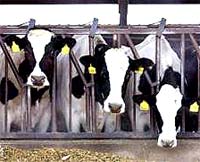
Meat from a Holstein sick with mad cow disease has now reached retail markets in eight states in the Untied States and one territory, but has not posed any health risk yet, US Agriculture Department officials said Sunday.
Kenneth Petersen, an Agriculture Department veterinarian, said investigators have determined that some of the meat from the diseased dairy cow slaughtered Dec. 9 in Washington State went to Alaska, Hawaii, Idaho, Montana and Guam. Earlier, officials had said most of the meat went to Washington and Oregon, with lesser amounts to California and Nevada, for distribution to consumers.
"The recalled meat represents essentially zero risk to consumers," said Petersen, of the USDA's food safety agency.
He said the parts most likely to carry infection -- the brain, spinal cord and lower intestine -- were removed before the meat from the infected cow was cut and processed for human consumption.
Mad cow disease, officially called bovine spongiform encephalopathy, is a concern because humans who eat brain or spinal matter from an infected cow can develop a related brain-wasting illness, variant Creutzfeldt-Jakob disease. In Britain, 143 people died of it after an outbreak of mad cow in the 1980s.
Despite their assurances of food safety, federal officials have taken the precaution of recalling 10,000 pounds of meat from the infected cow and from 19 other cows slaughtered Dec. 9 at Vern's Moses Lake Meat Co., in Moses Lake, Washington state.
Officials say they are still recovering meat and won't know how much has been returned until later this week.
Petersen said: "We expect by now that many of the customers who may have purchased some of this meat have been notified by the grocery chain or other store where perhaps they purchased it. If not, they can contact those stores" related to the recall.
Petersen said the slaughtered cow was deboned at Midway Meats in Centralia, Washington., and sent Dec. 12 to two other plants, Willamette Valley Meat and Interstate Meat, both near Portland, Ore. Petersen has said that much of the meat is being held by those facilities.
Willamette also received beef trimmings -- parts used in meats such as hamburger. Officials say those were sold to some three dozen small, mom-and-pop Asian and Mexican facilities in Washington, Oregon, California and Nevada.
Supermarket chains in the West -- Albertsons, Fred Meyer, Safeway and WinCo Foods -- have voluntarily removed ground beef products from the affected distributors. Safeway has said it will look for another supplier.
Despite assurances that American beef is safe, Japan and more than two dozen countries have blocked US beef imports. Jordan and Lebanon joined the list on Sunday. US beef industry officials this week estimated they've lost 90 percent of their export market because of the bans.
US agriculture officials arrived Sunday in Japan to discuss maintaining beef trade even as the United States investigates how the Holstein in Washington state got sick.
Dr. Ron DeHaven, chief veterinarian for USDA, said Sunday that science has shown certain meat cuts are fairly safe from infection. Among those are whole cuts without bones, such as beef steaks, roast, liver, and ground beef from labeled cuts like chuck or round.
DeHaven said this suggests the trade restrictions "are not well-founded in science."
Investigators have tentatively traced the first US cow with mad cow disease to Canada. This could help determine the scope of the outbreak and might even limit the economic damage to the American beef industry.
The tentative finding traced the cow to Alberta, the same Canadian province where scientists found a lone cow infected with the illness in May.
DeHaven stressed that officials still haven't confirmed this because US records outlining the animal's history do not match ones in Canada. Canadian officials have said it was premature to reach a firm conclusion.
The department said DNA tests will help resolve the matter.
Canadian documents show the cow had two calves before it arrived in the United States, contrary to US records which said it had never born calves.
Also, Canadian documents say the diseased cow was 6 1/2-years-old, but US records say it was younger, around 4- and 4 1/2-years-old.
The cow's age is significant because it may have been born before the United States and Canada in 1997 banned certain feed that is considered the most likely source of infection.
A cow gets infected by eating feed containing tissue from the spine or brain of an infected animal. Farmers used to feed their animals such meal to fatten them.
The FDA is looking into whether the cow ate contaminated feed -- a difficult task because the animal may been infected by feed it ate years before it appeared sick. BSE can incubate for four to five years.
Dr. Stephen Sundlof, head of the FDA's Center for Veterinary Medicine, said it takes as little as half a gram of infected material to sicken an animal.
"Even if a small amount of brain or central nervous system (material) were to get into cattle feed, there is the potential for even that very small dose to result in the disease," Sundlof said.
Officials are less certain how much would infect a human. "It's not known what dose would infect humans, but it would higher for humans than for cattle," Sundlof said.
Investigators have considered other ways the disease could spread. Although scientists have never found a case of mad cow infection being passed from a mother cow to its calf, they want to test the sick cow's calves as a precaution.
They also are seeking to determine whether the strain of BSE, a disease caused by a misshapen protein, is the same as the one that struck Europe in the 1980s and 1990s.
(China Daily December 29, 2003)
|

